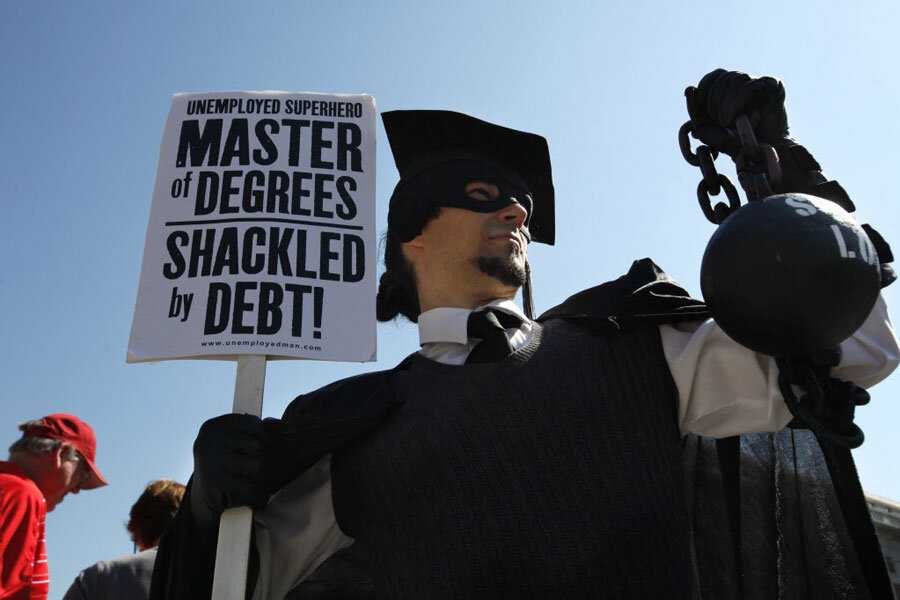Why the news on high college costs is starting to get (a little) better
Loading...
After years of attention to spiraling and out-of-control college costs, some of the more recent news shows movement in the other direction.
State cuts to higher education have largely bottomed out, and some states are starting to restore funding they had previously cut. Nationally, tuition to public higher-education institutions rose only 1.2 percent in the past year after accounting for inflation – a far cry from the steep rises right after the 2008 recession.
But that doesn’t mean state funding to colleges and universities – or tuition at those schools – is anywhere close to pre-recession levels.
According to a report from the Center on Budget and Policy Priorities (CBPP) released Wednesday, all but three states – North Dakota, Wyoming, and Alaska – are spending less per student than they did before the 2008 recession, and for some of the states the change has been dramatic.
“For the past couple of years, states by-and-large have been reinvesting in higher education, and we’re still 20 percent below what we were spending before the recession,” says Michael Mitchell, a policy analyst at CBPP and an author of the report. “It gives you perspective on the magnitude of cuts that were taking place.”
While state spending on higher education is down, on average, 20 percent since 2008, tuition at four-year public colleges is up 29 percent – or $2,068 – during that same time period. In a few states, the cuts have been particularly dramatic. Arizona, Louisiana, South Carolina, Alabama, and Pennsylvania all have cut their per-pupil spending by more than 35 percent since 2008, after accounting for inflation. And in nine states, tuition has risen by more than 50 percent during that time.
And while Mr. Mitchell says he’s encouraged that most states are starting to reinvest in higher education, that trend hasn’t been universal: 13 states cut funding for higher education again last year. In three of those – Kentucky, West Virginia, and Oklahoma – it was for the second year in a row.
A number of factors have contributed to the fact that tuition has been steadily rising two or three times the rate of inflation, analysts say. But in the past decade, state budget pressures – resulting in big cuts in higher education – has been the major driver.
College spending has been flat or declining since 2008, says Donna Desrochers, a principal researcher at the Delta Cost Project at American Institutes for Research. “Colleges and universities are struggling since the recession, and trying to figure out ways to become more lean and efficient,… but without additional state funding it’s difficult to hold [tuition] down,” Ms. Desrochers says, noting that states facing budget squeezes usually cut higher-ed funding first since it can get replaced with tuition.
The portion of a public education funded by student tuition has shifted from between 30 and 40 percent a decade ago to between 50 and 60 percent today, she says.
The effect on students can be significant. For Troy Frasier, who always assumed a public school was the best deal he could get, it meant rethinking options. He enrolled in the University of North Florida in 2009 but ended up transferring to avoid debt.
“It was going up like $50 an hour – enough that I was looking at it going, 'Is this degree worth it to get it here, or is there a cheaper, better option out there?' ” says Mr. Frasier, who transferred after two years to a small college in the Midwest where he found a better deal. “I was a Florida resident, I didn’t even know about private colleges, but I have less debt now than I would have if I had stayed where I was at.”
The total student debt load is now $1.16 trillion, and since the 2008 recession, both the percentage of students graduating from four-year public institutions with debt and the amount of that debt has increased significantly (by about $3,600, or 16 percent, adjusting for inflation).
And even when college costs are mitigated by student aid, research shows that for low-income students in particular, the sticker shock of higher tuition can keep many students from applying and cause them to think certain colleges are out of reach.
“For anyone who’s below wealthy, it’s a real struggle, because these numbers are huge, and obviously these debt loads are causing a lot of anxiety for parents and students,” says Iris Palmer, a senior policy analyst at the New America Foundation. “But this is such an anxiety-producing issue for the American electorate, I’m hopeful that politicians will see this as a winner for them and reinvest and bring down tuition.”
In Washington state recently, the Republican-controlled Senate proposed increasing the public investment in higher education, cutting tuition by 25 percent, and tying future tuition increases to the state’s average wage. (According to the CBPP report, Washington saw the third-largest tuition increase, of just over $4,000 on average, from 2008 to 2015.)
“It’s a really bold proposal, that’s responding to this anxiety,” says Ms. Palmer of the Washington proposal.
Reyna Gobel, a curriculum development specialist for iGrad, a financial-literacy organization for students, says that the rising tuition costs simply make it more paramount for students to look into scholarships, think carefully about how much debt they take on, and to look at community colleges and better-priced alternatives to public universities.
“We can’t change instantly how much schools are funded, but what we can do is be good consumers,” she says.








